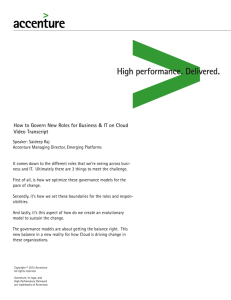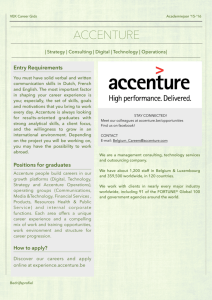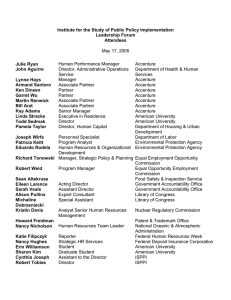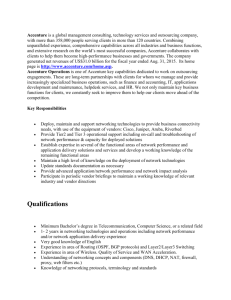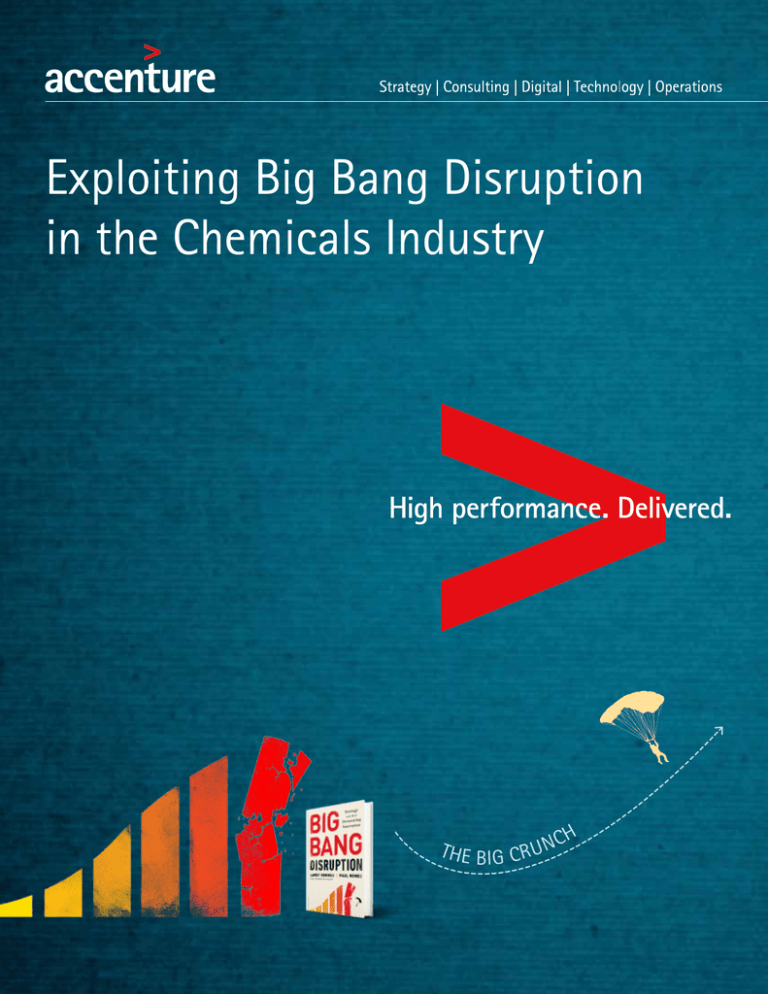
Exploiting Big Bang Disruption
in the Chemicals Industry
THE BIG CR U NC
H
Introduction
As chemical companies focus on making
the most of this growth, they also need to
think about what comes next. Accenture’s
research suggests that the Big Bang will be
followed by a sudden decline in growth—a
Big Crunch. That downshift in growth will
require a significant change in operations
and strategies.
With that in mind, North American chemical
companies need to understand the risks this
cycle will bring, and how to avoid stagnation
and decline as the Big Crunch unfolds.
They will need to rethink everything from
exports and global markets to increased
asset flexibility and supply chain efficiency.
And they should begin planning now, and
preparing to drive high performance as the
economic and competitive fundamentals of
the industry change.
NC
U
CR
H
In North America,
the shale gas revolution
is driving a boom in
the chemicals industry,
as companies invest
in new plants in order
to take advantage of
cheaper feedstock and
lower energy costs.
But this boom is more
than another turn in
the traditional business
cycle. It represents
a rapid and fundamental
shift for the industry—
a kind of Big Bang event
characterized by nearly
unconstrained growth.
BIG
E
TH
1
2
The Big Bang Cycle in the Chemicals Industry
Using the metaphor of the Big Bang theory of
the universe, they describe how industries will
often experience a stage of tremendous growth
(a Big Bang), followed by a period of industry
stagnation and below-average financial
performance (a Big Crunch). This sudden
change and decline is preceded by a relatively
stable period (Singularity) and followed by a
period of re-grouping (Entropy) (see Figure 1).
This Big Bang cycle is initiated by a disruption—
often technology-based—that fundamentally
changes the industry. Traditionally, broad
change in business has been driven by new
products, technologies or processes that are
either cheaper or better. Big Bang disruptors,
on the other hand, are typically both—they are
cheaper and better, and they emerge rapidly.
This type of scenario appears to be playing out
in the chemicals industry. Here, the disruptive
element is the shale gas revolution in North
America. Over the last several years, new
technologies and drilling techniques, such as
hydraulic fracturing and horizontal drilling,
have opened up access to shale gas in the
region, bringing large amounts of gas onto the
market in a relatively short time. Less than a
decade ago, high natural gas prices seemed to
be a permanent part of the landscape in the
region, and a key factor that was discouraging
industrial investment. By early 2009, however,
declining natural gas prices—coupled with
rising oil prices—made it clear that a structural
shift had occurred in the oil/gas price ratio,
and that cheap natural gas was here to stay
for the foreseeable future (see Figure 2).
3
Figure 1. Big Bang disruption.
Strategic imperative:
Asset freedom
Strategic imperative:
Scaling management
Strategic imperative:
Foresight
Strategic imperative:
End game mastery
The Big
Bang
The Singularity
The Big Crunch
Entropy
Sharkfin model
Figure 2. The global ethylene cost curve has shifted.
Ethylene cash costs of regional steam crackers
Ethylene cash costs, Constant 2013 $/tonne
In their book, Big Bang
Disruption, authors Larry
Downs and Paul Nunes
describe a cycle of rapid
growth and decline that
is increasingly common
across industries.
1600
1400
Asia LPG
1200
1000
800
Asia N
600
400
ME N
& LPG
200
ME E
ME E
0
0
EU LPG
EU N
NA N
Asia LPG
ME N
NA E
& NA LPG
ME LPG
EU LPG
EU N
Asia N
NA N
E = Ethane
N = Naphtha
LPG = Propane
NA E
40
60
80
100
Cumulative capacity, million tonnes/year
Source: ICIS Consulting.
2005
NA LPG
20
2013
120
140
160
4
This occurence has led to a Big Bang stage
of virtually unrestrained growth in the
North American oil and gas arena—and
downstream, in the chemicals industry.
Chemical companies from around the world
are investing in new plants in the region,
largely to take advantage of low-cost gas
as a feedstock, as well as an energy source
(see Figure 3). According to the American
Chemistry Council, announced US chemical
industry investments that are linked to the
shale gas boom now top $100 billion—and
it seems that there is more to come. In
a recent Accenture/ICIS global survey of
chemical companies, more than half of
the respondents said that they are already
increasing or are planning to increase their
levels of investment in North America over
the next two years. The United States and
Canada topped the list of regions in which
companies are investing, slightly ahead of
China and significantly outranking Western
Europe and the Middle East and Africa.
The question is, how is this period of growth
likely to lead to a Big Crunch? Experience
suggests that such growth will eventually
reach its limits and slow down. As more
and more players invest in North America,
the field will eventually become saturated.
In addition, the industry will reach a point
where the availability of low-cost gas is
not “new” anymore, and most companies
will be able to take advantage of North
American gas as well as low-cost feedstocks
from other regions. Crude oil development
(encouraged by high oil prices) may also
create greater oil supply, reducing oil prices
relative to natural gas.1 For example, Mexico
is embarking on a policy to allow and
encourage foreign investment in hydrocarbon
resources. These developments are also
causing other Latin American countries to
consider policies to attract investment as
well. Overall, then, the entire global cost
curve will shift down, and create a new, lower
and flatter “normal” for costs—eroding the
competitive advantage that many companies
enjoyed at the start of the Big Bang.
That picture may be further complicated
by increased North American exports of
ethane—derived from natural gas—by the
end of this decade. At least one chemical
producer and one major gas company have
already announced plans to ship ethane
Figure 3. North America is the focus of gas-based chemicals investment.
Ethylene capacity development based on confirmed announcements
45,000
2013
2023
40,000
35,000
30,000
25,000
20,000
15,000
10,000
5,000
0
North
America
Latin
America
Europe
Former
USSR
Africa
Source: Accenture Research analysis of ICIS Consulting data.
5
Middle
East
Asia and
Pacific
Other
NEA
China
from the United States to markets such as
Europe. Even with shipping expenses, this
ethane may well be cheaper than alternatives
such as naphtha. Such developments could
flatten the global cost curve, adding another
contributing factor to the Big Crunch.
This scenario can be represented visually
as a “sharkfin” graph, where a sharply
rising growth line (representing industrial
activity such as investments or profits)
peaks and then declines fairly quickly
(see Figure 4). Accenture’s research
indicates that the shift to the Big Crunch
will likely occur in the 2020 time frame,
ushering in a period of lower margins and
increased consolidation and realignment.
Table 1. Chemicals Big Bang timeline.
1980 to 1990
1990 to 2000
2000 to 2008
2008 to 2020
2020 and beyond
Big Bang
Big Crunch and Entropy
Singularity
Oil/gas developments
•Aftermath of energy shock
•Begins with oil
•Low gas prices/declining oil prices •Horizontal well in Barnett Shale
•Horizontal drilling: Austin Chalk
•Low gas prices; oil prices mostly
stable and low
•Sharp rise in gas prices starting
in 2000
•Gas prices plummet; oil prices at
high levels
•Gas E&P ramps up using fracking •E&P focuses on oil and wet gas
and horizontal drilling
•Transport hazards and backlogs
•Ends with mergers
•New gas uses
•New oil sources
•Consolidation
•Gas/oil ratio adjusts
•High foreign investment into
North America
Chemical environment
•Strong GDP and chemicals
margins (late ‘80s)
•China and Middle East ramp up
•Shift to liquid cracking
•Asia crisis
•North America investment
plummets
•Limited emerging market capacity •Capacity growth slows in North
America
•Shift to gas cracking;
co-product shortages
•Global cost curve shifts down
•High number of new players
in North America
•High margins
•Focus overseas
•Investments announced for
North America
•Scale exports
•Possible global over-capacity
•Talent shortage; construction
cost escalation
Imperatives
• Grow domestic share
• Expand in China and Middle East • Grow overseas
• Build with less talent
• Improve process technology
• Maintain North America market
share
• Re-orient supply chains
• Differentiate and substitute
• Focus on cost reduction
• First-quartile global production
costs
• Avoid the “whipsaw”
• Secure base load overseas
customers
• Consolidations
• Create asset agility
• New routes to “lost” co-products • Contingency management
• Emphasize “foresight” and strategy
• Protect domestic share
Figure 4. Chemicals industry “sharkfin.”
Decade themes
1980s “Strengthen the home market”
1990s “Age of Globalization”
2000s “The oil/gas shift begins”
2010s “Investment rush”
2020s “Crunch”
The Big Bang
The Singularity
2010
1980
The Big Crunch
2020(?)
Oil/gas ratio
Entropy
2030(?)
Fracking patents
60
50
40
30
20
10
0
?
200
150
100
Oil/gas price ratio critical point
50
0
1980 1983 1986 1989 1992 1995 1998 2001 2004 2007 2010 2013 2016 2019 2022 2025 2028 2031 2034 2037 2040 2043 2046 2049
Oil/gas ratio
Fracking patents
Source: IEA; Thomson.
6
Taking Action: Key Imperatives for the Big Crunch
The Big Crunch
environment will require
different approaches
from those used during
the Big Bang. To perform
well in this stage,
chemical companies
will need to adjust their
strategies, keeping four
key imperatives in mind:
Each of those steps involves transportation
and storage costs, and the potential for delay.
To avoid such problems, chemical companies
can build more of those facilities at one site—
and there is often an opportunity to do so
with the current Big Bang investment levels.
Some companies are taking this approach—
but many others are not.
• Establishing effective contingency
management.
Chemical companies also have an opportunity
to control costs in plant construction. Plants
are getting larger, making construction
more difficult to manage. The industry has
seen a number of major projects that have
experienced huge cost overruns—some on the
order of $1 billion—and lengthy delays. Those
costs can have a significant impact on the
long-term profitability of a plant, and later
start dates can mean missed opportunities to
take advantage of market upswings. Chemical
companies can bring more rigor to the
management of these capital projects in order
to complete them on time and within budget—
which can have a significant impact on their
overall cost picture. For instance, an ill-timed
start-up would have equated to approximately
$700,000 of lost cash flow per day for a new
North American ethylene cracker in 2011.2
Achieving and maintaining firstquartile global production costs
Avoiding the “whipsaw” of
oversupply and reduced margins
Having low costs is always important in the
chemicals industry, but during the Big Crunch,
it will be critical, as companies will need to
compete globally on a delivered-cost basis.
In the Big Crunch, companies are likely to run
into the whipsaw effect of having to recoup
large capital investments as capacity moves
into excess, margins decline and competition
for market share grows.
• Achieving and maintaining first-quartile
global production costs.
• Avoiding the “whipsaw” of oversupply and
reduced margins.
• Increasing asset agility.
Securing access to low-cost raw materials
will continue to be key. So too will low-cost
production capabilities. To a great extent,
the industry has done well at establishing
large-scale, efficient ethylene crackers that
keep production costs down. Indeed, much
of today’s Big Bang investment is focused on
such plants. But chemical companies need to
take the next step, and extend that efficiency
out into all stages of production, and into
supply and distribution.
For example, chemical companies today
typically (but not always) co-locate ethylene
crackers and polyethylene plants at the
same facility. They often ship products by
rail or truck from there to a warehouse or
a packaging facility, and then on to the
customer or to a port for further transport.
7
In that environment, the plant and supply
chain efficiencies discussed earlier will be
vital. Companies will also need to gather and
use more timely information about global
operations and markets to quickly identify
opportunities and root out costs.
Strong relationships with customers and
channel partners will be particularly
important, and key to understanding what
customers truly value and avoid the need to
compete solely on price. Companies that have
a large technology portfolio and the ability to
collaborate and tailor products and services
to specific customer needs will be in a better
position to thrive.3 Those that focus simply
on low-cost commodity production—the
approach possibly being pursued by a number
of new entrants in the North American
market—are likely to struggle post Big Bang.4
At the same time, North American producers
will need to place a stronger emphasis on
exports and global markets—which will require
some rethinking of current approaches. Today,
North American chemical exports tend to be
something of an ancillary business. Companies
typically work closely with domestic customers
and sell the remainder of their product on the
global spot market.
That approach can be highly profitable in the
Big Bang stage—but not in the Big Crunch
era, because there simply will not be enough
domestic demand to go around. In the
Accenture/ICIS research, about 77 percent of
the respondents who are investing in North
America said that they plan to focus on
that region as a destination market for the
output of their new capacity investments.
However, by the beginning of the Big Crunch,
the North American chemicals industry may
have up to 1.6 times the ethylene-producing
capacity the market needs, if all the currently
discussed expansions come to fruition.
Clearly, then, most producers will be reliant
on exports to absorb new capacity. Exporting
will make up a larger and larger portion of
business for North American producers.5 That
means that it can no longer be a secondary
concern. Instead, companies will need to
build closer, more collaborative relationships
with overseas customers by providing them
with more technical support and services,
building application development labs in
other markets, and working in strategic
partnerships with overseas customers. The
goal, ideally, will be to obtain high-value,
base-load overseas customers that can take
up a large share of the company’s North
American production capacity—and thus
create sustainable demand and maintain
acceptable margins.
Increasing asset agility
In the Big Crunch, companies will need to
adapt to changing economics and meet
the evolving needs of a range of customers
around the globe. Having assets that allow
them to adjust and avoid being tied to one
approach—that is, “asset freedom”—will be
key to achieving a sound return on capital
across the changing business cycle.
With that in mind, chemical companies
need to bring greater flexibility to the asset
base, perhaps by establishing supply points
such as plants or alliances in overseas
markets. Companies can build flexibility into
transportation, and develop networks that
allow them to vary their use of railroads,
trucks and ships as needed. In essence, this
adds up to having multiple options, and being
able to quickly reconfigure the production
and transportation network to adapt to
changing needs—and keep asset utilization
high across the Big Bang and the Big Crunch.
For example, North American producers might
want to leverage various port options for
exports. It may be that chemical companies
can create alliances with container carriers
that make it more attractive to send products
out through historically nontraditional
ports. Doing so could enable them to take
advantage of more attractive rates because
it could allow carriers to balance cargos.
Building packaging facilities at these
alternate ports may also be an option, hauling
resin in covered hopper cars to the port area
before packaging and containerization.
Companies can also consider innovative legal
and business structures to help them get the
most out of their assets. For example, a 2012
US IRS ruling allows the use of master limited
partnerships, or MLPs, for some chemical
operations, including ethylene crackers. This
allows a chemical company the flexibility to
monetize existing assets and potentially fund
new projects, through the MLP structure,
typically combined with an off-take agreement
and a contract with the MLP to manage
the assets. MLP can provide significant tax
advantages, enable the company to capture
more value from the cracker asset, and provide
additional funds to finance growth. It also
represents a lower-risk investment with stable
returns, making it attractive to investors. At
least one chemical company has pursued this
MLP strategy, and it seems likely that others
will soon do so, as well.
Also, the large magnitude of new capacity
coming online can be viewed almost as a
“rebuilding” of the industry within the holistic
context that includes infrastructure. Besides
the focus on ramping up new high-value
scale assets, companies need to be explicitly
involved in the development of infrastructure
and policy to accommodate the same growth.
For instance, the economics of container and
parcel tanker movements in Gulf Coast ports
will depend on further port development. If all
the discussed ethylene crackers for the Port
of Houston service area were to come into
fruition, the new material alone could account
for an approximate 11 percent increase in
export freight volume by 2018. This excludes
anticipated increases from other industrial
exports that are likely to occur, related
to energy, fuels and other manufacturing
in the US Gulf Coast. Port depths and
breadths, across the Gulf Coast may need to
accommodate the ship sizes allowed after the
Panama Canal expansion. The benefit would
mean improved shipping economics, as freight
costs can reduce by almost 50 percent per unit
with larger ships, increasing the competitive
pressures between alternative routes (such as
rail to West Coast ports).
Petrochemicals companies are currently
very focused on expanding capacity on
time and within budget and sometimes the
efforts needed on the broader infrastructure
are neglected. For example, company
coordination and support through local
organizations for things as simple the
construction of a new, low-cost, bridge
to alleviate port road/rail bottlenecks can
be crucial. While the cost of this may be
significantly less than building a cracker,
not making the investment can cause
backlogs, delays and higher costs when
the crackers and associated derivative
plants start up. Therefore, companies must
work with federal and local governments,
carriers, as well as port authorities and
other industries to ensure the proper
infrastructure investments are made.
Establishing effective
contingency management
To a great extent, planning in the industry
is based on an extrapolation of today’s
trends. For example, many companies now
assume that there will be continued demand
growth in Asia, and that low-cost natural gas
feedstocks will provide an ongoing advantage
for the North American region. But the future
can be difficult to predict. Consider the fact
that just a few years ago, chemical companies
thought that high gas prices had more or
less permanently put an end to new plant
investment in North America.
A number of factors could change the
industry’s course. For example, demand in
China could slow down further and materialperformance requirements could become more
rigorous as manufacturers there focus more
heavily on durable goods that call for a higher
degree of sophistication (see Figure 5). Or
shale developments in other regions, such as
the Middle East, Mexico or China, could bring
new sources of low-cost feedstock into the
market. And of course, the upheaval created by
Big Crunch itself could open the door to new,
unforeseen risks and opportunities.
In a world where change is both rapid
and hard to predict, chemical companies
may need to take a more formal approach
to contingency planning. They must also
understand, quantify, plan and monitor key
risks, and be prepared to mitigate risks as they
arise. To do so, they can establish a business
intelligence/analytics program that monitors
energy, economic and political developments
and outlooks. Such programs can also help
them predict trends in customer industries,
globally, and therefore support improved
planning sales, production and distribution.
Figure 5. China’s changing product mix.
China finished good export shares
%
100
90
80
70
60
50
40
30
20
10
0
1Q00
1Q14
Nondurable
Durable
Note: Basic materials excluded.
Based on a classification of 85% of China’s exports.
Source: Accenture analysis of GTIS data.
8
Conclusion
To successfully and profitably navigate beyond
the current Big Bang and into the upcoming Big
Crunch, North American chemical companies will
need to recognize and contend with rapid change,
and be prepared to adjust their business strategies
and the way they operate in a relatively short
time frame. That shift will evolve over the next
few years, but companies should begin preparing
for it now. That means recognizing that today’s
boom cannot continue indefinitely, and positioning
for the next stage of evolution. Taking time now
to plan for this shift can help companies position
themselves to thrive both today and tomorrow.
9
10
References
For more information
1. For more information, see Accenture’s
analysis at: http://www.accenture.com/
us-en/blogs/cnr/archive/2014/03/26/shaleresources-in-mexico.aspx.
To read more about Big Bang Disruption
go to www.accenture.com/microsites/
bigbangdisruption or contact:
2. “Achieving Effective Delivery of Capital
Projects: Insights from the Accenture Global
Survey of the Chemicals Industry,” Accenture,
February 2013; http://www.accenture.
com/us-en/Pages/insight-capital-projectschemicals-industry.aspx.
3. “Innovation will be critical to survival
in North American chemicals” Accenture
blog, June 17, 2014; http://www.accenture.
com/us-en/blogs/cnr/archive/2014/06/17/
innovation-will-be-critical-to-survival-innorth-american.aspx.
Paul Bjacek
Houston, Texas
paul.bjacek@accenture.com
Kurt Eichhorn
Hartford, Connecticut
kurt.w.eichhorn@accenture.com
Jean Paul Masso
Houston, Texas
jean-paul.masso@accenture.com
If you have a QR reader installed on your
smartphone, simply scan this code to be
taken directly to the Accenture Big Bang
Disruption page:
www.accenture.com/microsites/
bigbangdisruption
John Poisson
Phoenix, Arizona
john.p.poisson@accenture.com
4. Ibid.
5. “Preparing for a Changing Petrochemical
Supply Landscape,” Accenture, October 2013;
http://www.accenture.com/us-en/Pages/
insight-preparing-changing-petrochemicalsupply-landscape.aspx.
About Accenture
Accenture is a global management
consulting, technology services and
outsourcing company, with more than
293,000 people serving clients in more
than 120 countries. Combining unparalleled
experience, comprehensive capabilities
across all industries and business functions,
and extensive research on the world’s
most successful companies, Accenture
collaborates with clients to help them
become high-performance businesses and
governments. The company generated
net revenues of US$28.6 billion for
the fiscal year ended Aug. 31, 2013. Its
home page is www.accenture.com.
This document is produced by consultants
at Accenture as general guidance. It is not
intended to provide specific advice on your
circumstances. If you require advice or
further details on any matters referred to,
please contact your Accenture representative.
Copyright © 2014 Accenture
All rights reserved.
Accenture, its logo, and
High Performance Delivered
are trademarks of Accenture.
14-3970


